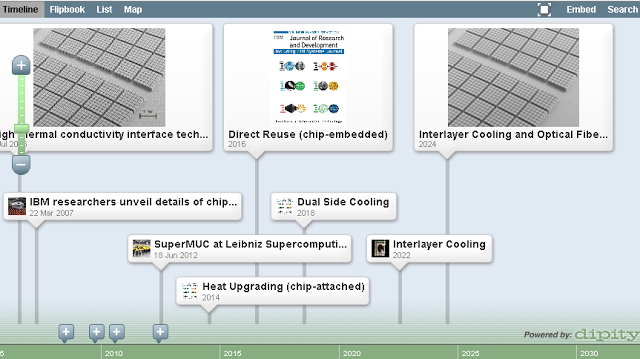

| Visitors Now: | |
| Total Visits: | |
| Total Stories: |

| Story Views | |
| Now: | |
| Last Hour: | |
| Last 24 Hours: | |
| Total: | |
IBM Supercomputer in Germany Points the way to Water Cooled 3D chips for Desktop Supercomputers
From
IBM is developing energy-efficient run-time thermal control strategies to achieve energy-efficient cooling mechanisms to compress almost 1 Tera nano-sized functional units into one cubic centimeter with a 10 to 100 fold higher connectivity than otherwise possible. This will hopefully enable compact mobile supercomputers with the power of todays room sized systems in a desktop package in the 2017-2025 timeframe.
SuperMUC combines its hot-water cooling capability, which removes heat 4,000 times more efficiently than air, with 18,000 energy-efficient Intel Xeon processors. In addition to helping with scientific discovery, the integration of hot-water cooling and IBM application-oriented, dynamic systems management software, allows energy to be captured and reused to heat the buildings during the Winter on the sprawling Leibniz Supercomputing Centre Campus, for savings of one million Euros ($1.25 million USD) per year.
There are flickr photos of the IBM SuperMUC
DARPA
A new DARPA program seeks to cool chips, chip stacks from within
The continued miniaturization and the increased density of components in today’s electronics have pushed heat generation and power dissipation to unprecedented levels. Current thermal management solutions, usually involving remote cooling, are unable to limit the temperature rise of today’s complex electronic components. Such remote cooling solutions, where heat must be conducted away from components before rejection to the air, add considerable weight and volume to electronic systems. The result is complex military systems that continue to grow in size and weight due to the inefficiencies of existing thermal management hardware.
Recent advances of the DARPA Thermal Management Technologies (TMT) program enable a paradigm shift—better thermal management. DARPA’s Intrachip/Interchip Enhanced Cooling (ICECool) program seeks to crack the thermal management barrier and overcome the limitations of remote cooling. ICECool will explore ‘embedded’ thermal management by bringing microfluidic cooling inside the substrate, chip or package by including thermal management in the earliest stages of electronics design.
See more and subscribe to NextBigFuture at
Source:



